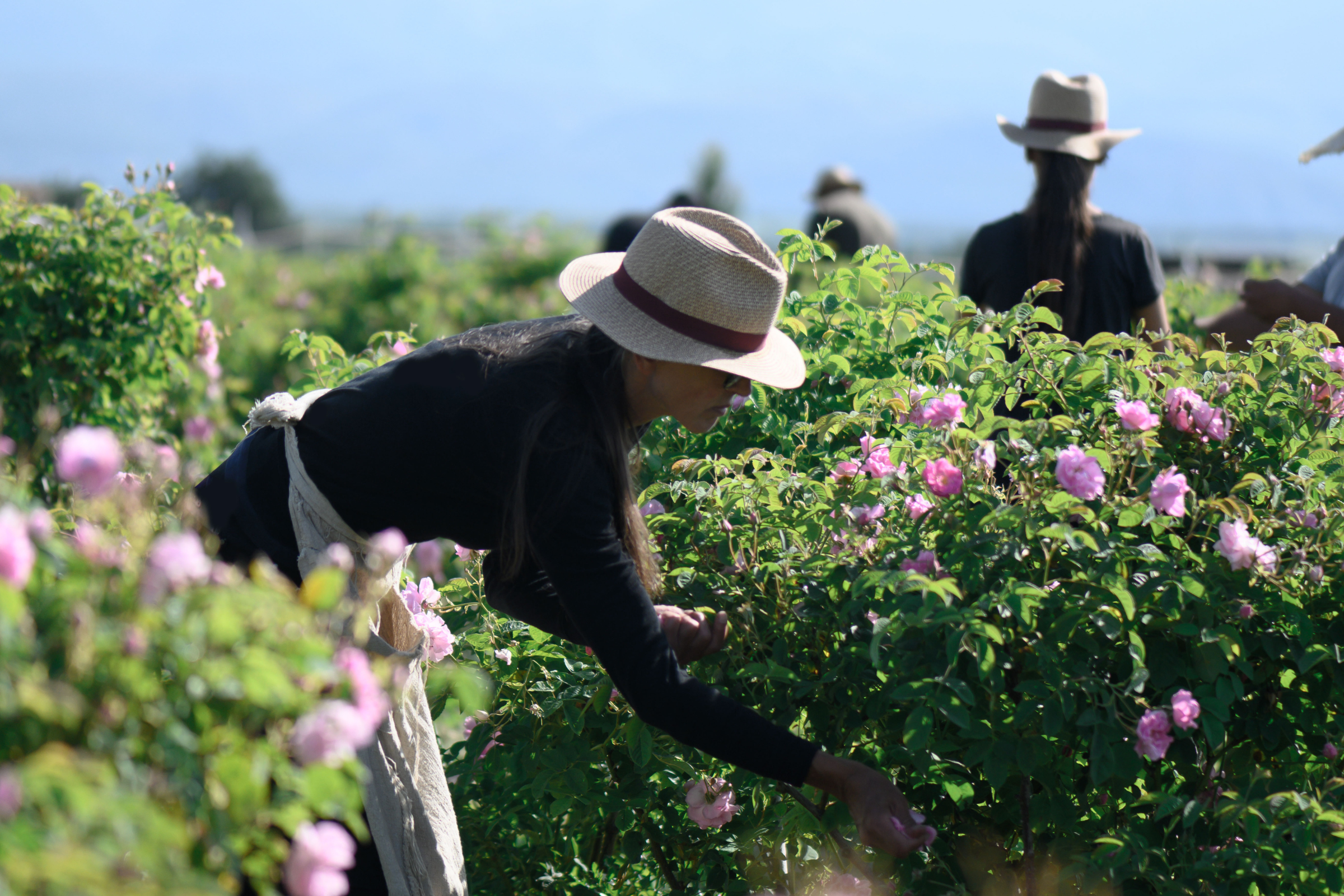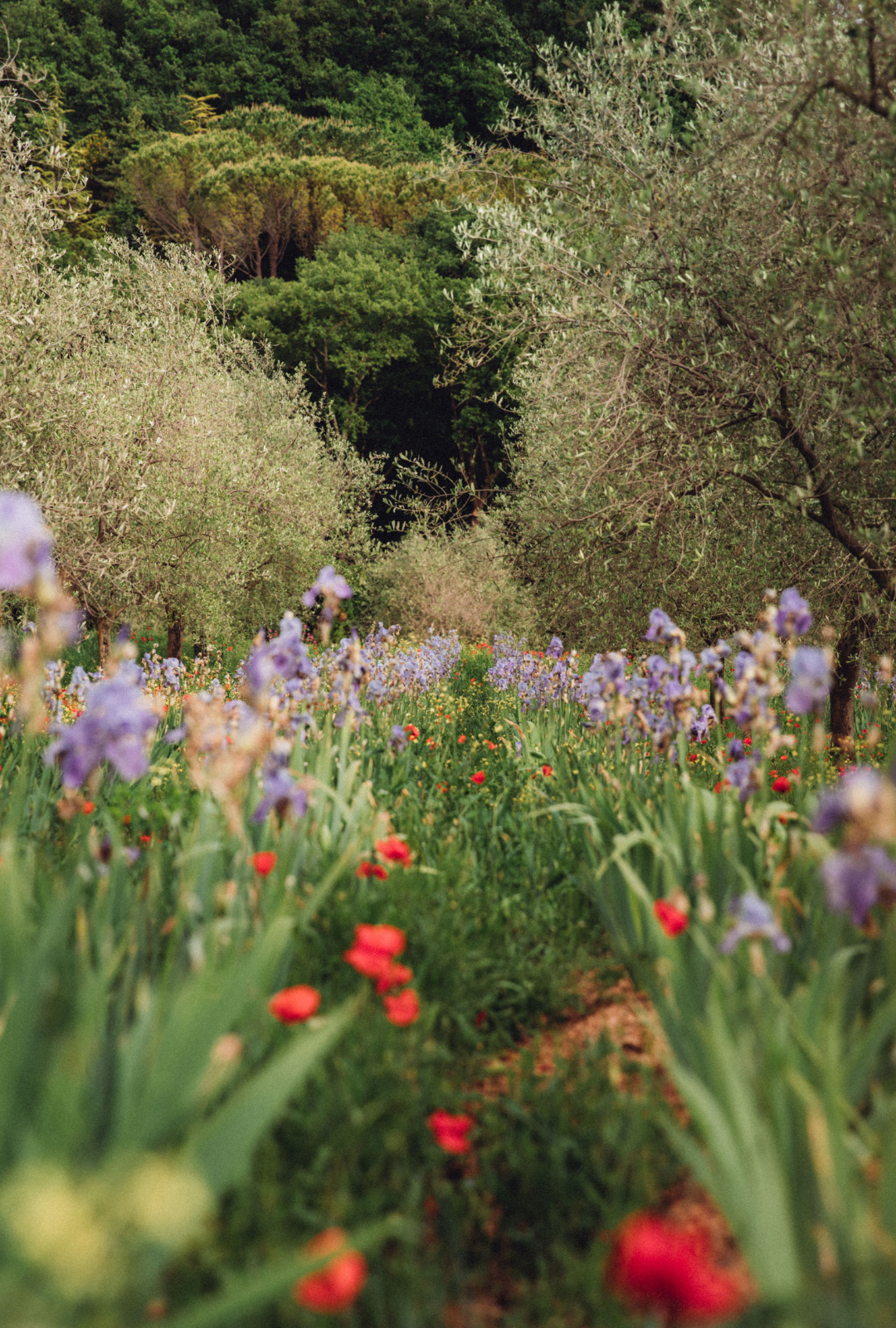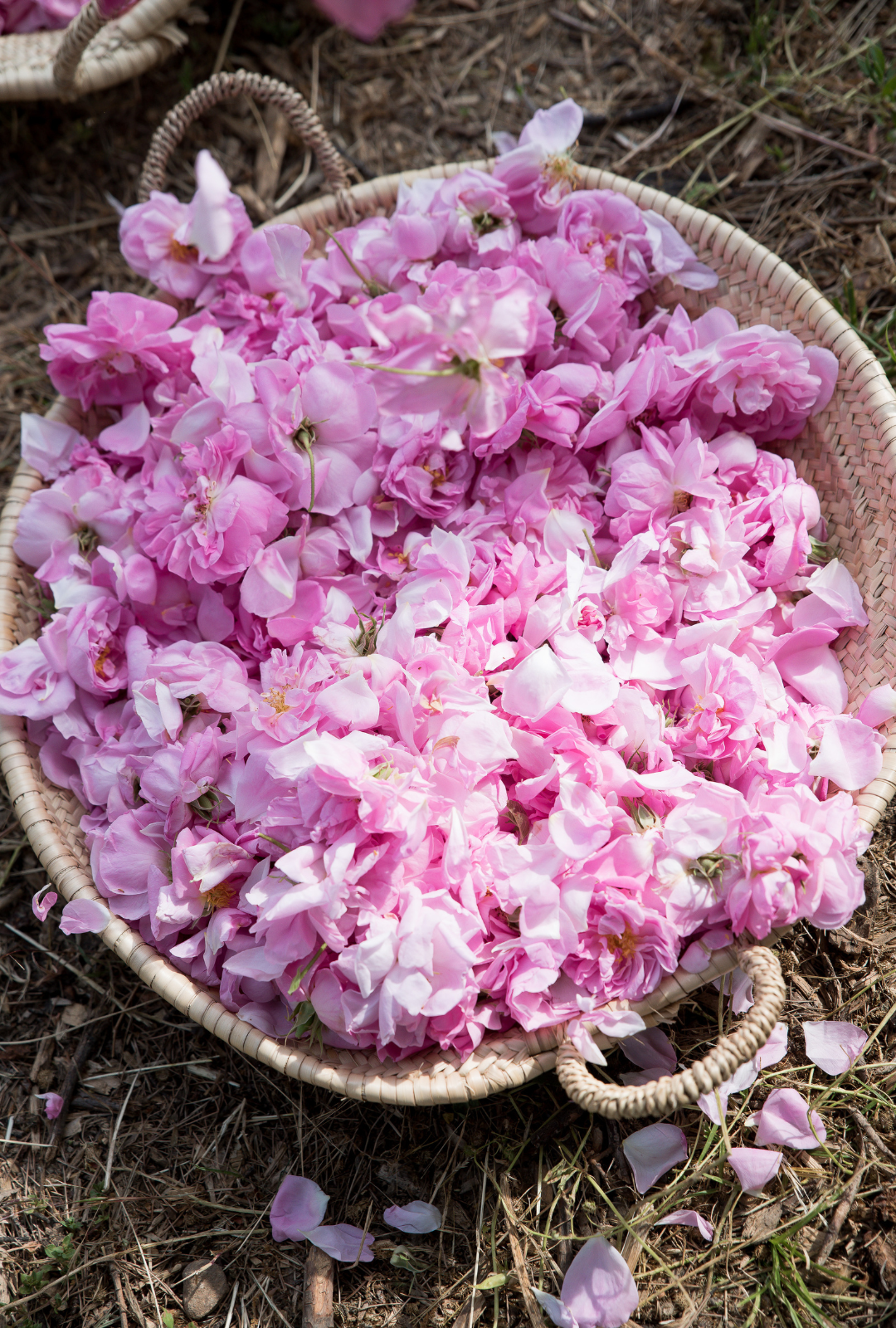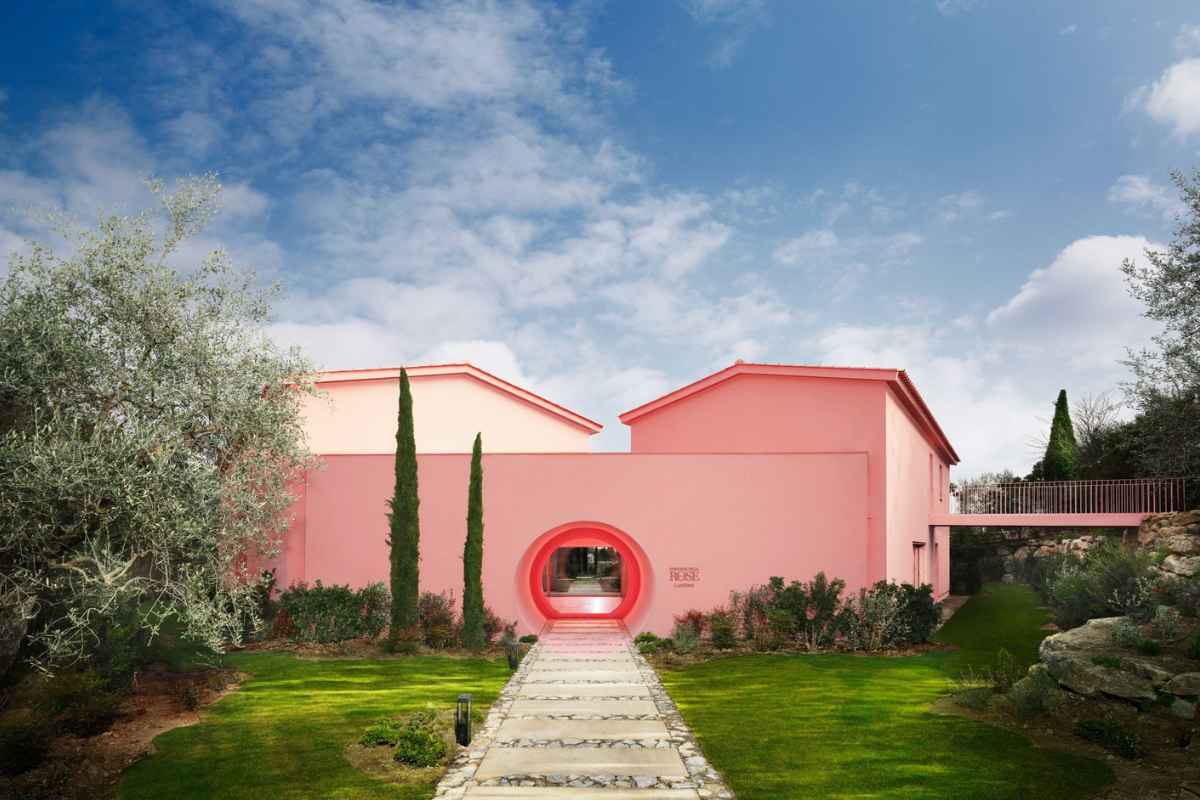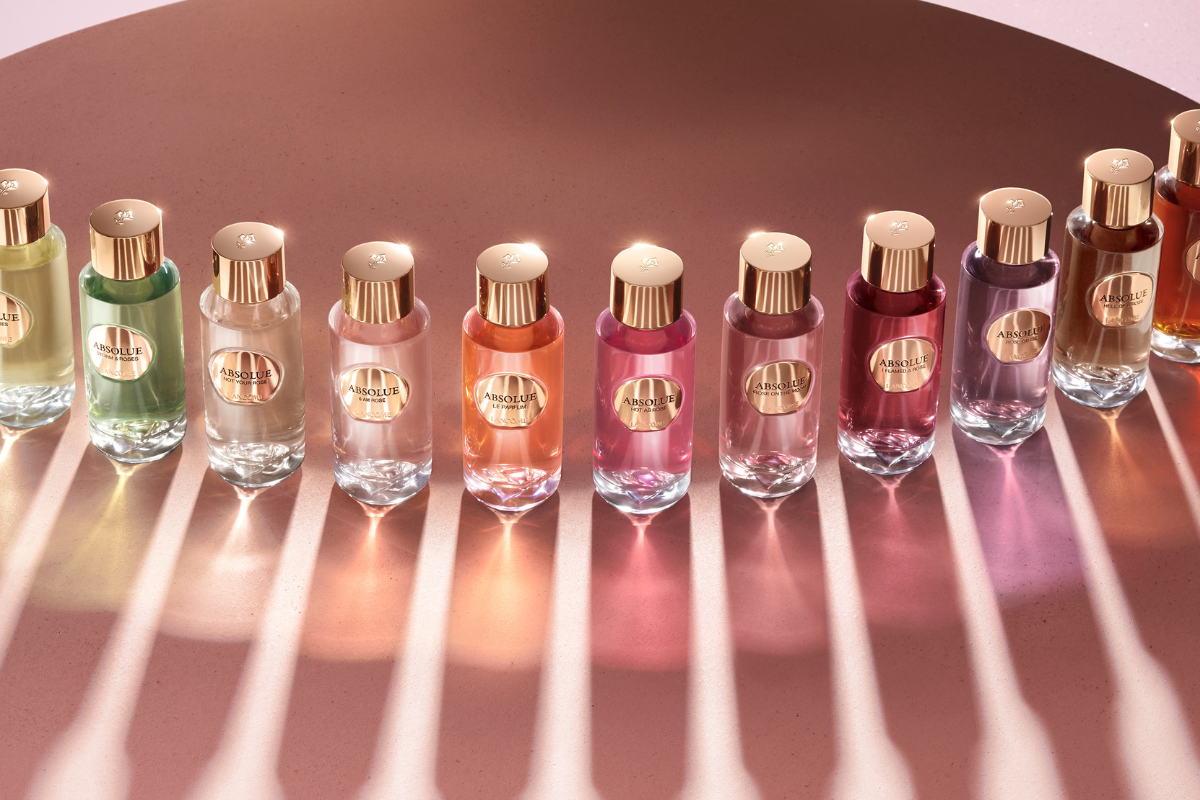My apron is full, and it smells better than any other garment I have ever worn. It is 9:30 on a balmy Wednesday morning in May, and I have just spent the better part of an hour learning how to pluck the perfect Rosa centifolia or rose of May. The elusive flower blooms once a year for a three-week period, typically starting in early to mid-May. Dusted in jet lag, I’ve arrived at Domaine de la Rose, Lancôme’s dreamy organic farm in Grasse, on the French Riviera, just in time for the annual harvest.
“Ah, this one is good,” says Antoine Leclef, Domaine’s chief horticulturist. He holds a tiny but beautiful blossom in his hand. The flowers are freshest when they are in full bloom, between 9 and 10 in the morning, he explains in a soft French accent slightly more gentle than what you encounter in Paris. “You see the yellow heart of this rose?” he says. “That’s how you know it’s ready to be plucked. Put two fingers underneath the blossom and your thumb on top,” he instructs. “Then press a little on top and gently rotate as you pull up.” A perfectly intact bloom pops into his outstretched hand, and he slides it into his apron. “Now you try it.”
It’s 87 degrees today, and I can feel the Mediterranean sun beating down on my bare shoulders. Distracted by thoughts of the sunscreen I’m not wearing, I mangle the first few roses. “You have to roll with your hand,” Leclef says. “When you do it well, it makes the right sound.”
Moments later, I hear a tiny snapping sound and am rewarded with what can only be described as the most intoxicating scent I have ever encountered. “Oh my god,” I whisper, reluctant to put the bloom down. Inhaling deeply, I close my eyes and have an almost out-of-body experience. Like Proust’s madeleines, this perfectly cultivated rose of May — grown without a trace of chemicals and picked at its peak of aromatic development — has triggered a sensory memory so strong and visceral that I feel my entire body relax. Suddenly, the years fall away, and I am back on Marginal Way in Ogunquit, Maine, my feet covered in sand and my nose nestled in its happy place: deep in the fragrant heart of the wild roses that grow along the craggy shoreline.
The intense emotional response I experienced when first smelling the Rosa centifolia at Domaine can be explained by basic neuroscience: The olfactory bulb — the structure in the brain that receives and relays the scents we breathe in — is directly connected to both the memory-focused hippocampus and the amygdala, which regulates emotions. But I prefer Proust’s more poetic explanation of the transportive nature of smell: “A single sound, a single scent, already heard or breathed long ago, may once again, both in the present and the past, be real without being present, ideal without being abstract, as soon as the permanent and habitually hidden essence of things is liberated, and our true self, which may sometimes have seemed to be long dead, but never was entirely, is re-awoken and re-animated when it receives the heavenly food that is brought to it.”
While I knew it wasn’t the same scent — like wine, each rose’s fragrance is affected by countless variables of the unique terroir, like water, temperature and elevation — I couldn’t help but wonder if the intensity of the scent memory had something to do with the clarity of the rose molecule in the absence of chemicals. After all, the roses at Domaine, like those of my childhood — and me at the time — were wild and free.
• • • • •
When Françoise Lehmann, Lancôme’s global brand president, first set eyes on Domaine in November 2019, her dream was to create a place that would honor Lancôme’s heritage while moving the brand in a more sustainable direction. Currently, 93% of the ingredients used in Lancôme fragrances are biodegradable, and 73% are bio-sourced. By 2030, the brand is working toward a goal of using 100% sustainably sourced, bio-based ingredients. Today, 100% of what is cultivated at Domaine is organic.
“The people who originally owned the property started farming organically in the sixties, and the people at the other farms thought they were crazy,” says Lehmann. “They said, ‘Why would you grow two roses when you could grow 10 with chemicals?’”
Turns out, the decision to choose only organic growing methods was prescient. “One of the reasons the soil is getting so poor in many other places is because of intensive monoculture farming with lots of pesticides,” says Lehmann. “This is why so many species of birds and animals have disappeared.”
By contrast, the creatures are alive and very present at Domaine. As I continue my tour with Leclef, we are serenaded by 33 species of birds. “The biodiversity really helps the flowers thrive,” he explains, noting that Domaine is also host to 31 species of butterflies, eight species of dragonflies, 12 species of bats and a whole bunch of snakes, mice and other critters. I watch for snakes as we step through the long grass and arrive at a very pregnant mulberry tree, one of 163 species of plants on the property. “You can eat it, go ahead,” Leclef encourages as a rooster crows loudly from the terraced fields behind us. I pluck one of the swollen fruits from a branch and take a bite. It explodes in my mouth. Like the scent of the rose, the flavor of the berry is unlike anything I have ever experienced. Fresher, sweeter, juicier. “Is this what you put in the Lancôme jams?” I ask, making a mental note to stock up before I head home. “No,” says Leclef. “We grow the berries for the birds. They love them!”
“Birds are not crazy,” Lehmann jokes. “They probably all called each other, saying, ‘Come on over here. There should be fewer pesticides at this place!’” While the birds help pollinate the roses, local sheep help prune them. “They are very good workers,” Leclef notes with a mischievous smile. Even the snakes are helpful, he adds. “They eat the mice that can damage crops and spread diseases.”
As we walk, Leclef points out dozens of fresh herbs and wildflowers. “Here is the rosemary,” he says, plucking an exquisitely aromatic stem. “Oh, and this is one of my favorite smells because it reminds me of my grandmother,” he continues, snapping off two green leaves from a bitter-orange tree. “She used a Roger & Gallet soap that smelled just like this. Crush the leaves together and then smell your hands.” I do as I’m told and can’t believe the scent that wafts up to my nose. Woody and hesperidic with a faint hint of floral neroli, it smells shockingly similar to a scented soap my boyfriend in college used that came from Mallorca. He gifted it to me before he went abroad for his junior year in Italy. I pocket my leaves and briefly contemplate picking a few more.
As we reach the end of our tour, we transfer our fresh rose petals into a large burlap sack. (I get permission to sneak a handful into my backpack as a souvenir.) Next, we will transport the petals for processing to dsm-firmenich, a global company with a local perfume distillery. The flowers need to be transported to the factory as quickly as possible; even a delay of just one hour can compromise the integrity of the scent. Today, I have filled half my apron with fresh petals. Leclef says seasoned harvesters like Madame Lafleur (yes, that’s her real name; she has been working here for 50 years) can sometimes fill up to 20 times this amount in just one day using a swift, two-handed method (apparently she can bank four to five kilos in an hour, which makes her something like the Simone Biles of rose picking). This is important because, as Leclef notes, “it takes 800 kilograms of fresh rose petals to make just one kilogram of rose absolute (the intensely scented and highly concentrated oil that perfumers use in fragrances).”
“Smell inside the bag,” Leclef suggests with a broad smile. I gently poke my head into the sack and swoon at the heady aroma. “This must be what heaven smells like,” I think out loud as we jump into a waiting car and head to the distillery.
By comparison to the idyllic horticultural wonderland that is Domaine, the dsm-firmenich fragrance-processing building is where romance meets reality. It is a large, white, uncharming box surrounded by lots of security. Reprimanded about taking a photo, I am reminded of what Leclef said about the perfume industry: “It’s very secretive!”
However, it isn’t long before I am allowed access to the inner sanctum of this inauspicious factory. We don special sterilized boots before entering the lab, where we meet Cyril Mestre, a dsm-firmenich perfumer. We hand him our bag of petals, which he deposits into a machine that can best be described as a flower microwave. After 17 minutes, this process has created a small vial of extremely fragrant rose water. “We call this the watery phase,” says Mestre. “We collect the most interesting aromatic molecules in the flowers by using only water and no petrochemicals. When you use chemicals, you destroy a lot. This new water-based technology allows us to preserve as much of the original scent as possible.”
• • • • •
The next stop on our adventure is the Barbie-pink main building of Domaine, where Audrey Dangy-Caye, one of Lancôme’s olfactive experts, shows us how perfumers combine different ingredients to make a fragrance. Glass bottles filled with 2,000 raw materials (200 natural and 1,800 synthetic) line four curvilinear shelves of a large workstation known as the fragrance organ. Here I finally smell the much-discussed iris root, which has a sweet, soft, powdery, suede-like scent. We also smell various Rosa centifolia extracts, all differing slightly based on the extraction technology used to capture their olfactive molecules.
After taking our noses on a dizzying journey through dozens of interesting raw fragrance extracts, Dangy-Caye introduces the pièce de résistance: Absolue Les Parfums, a new, rose-centric collection from Lancôme that is launching in September. There will be 11 fragrances in the line, and nine are brand-new. “The idea for this collection is to discover the rose as you’ve never smelled it before,” says Dangy-Caye. By combining the Rosa centifolia from Domaine de la Rose with different ingredients, you can experience the many complex facets of the rose. We thought, why not create a fresh rose, a woody rose, a green rose. …”
The first fragrance, 6 AM Rose, was created by perfumer Fanny Bal at IFF (International Flavors & Fragrances). “This one combines the neo- Absolue centifiola extract with juicy green fruit, lily of the valley, cassis and ambrette seeds,” says Dangy-Caye. We smell five more scents, each more complex than the last. The final scent, Hell of a Rose, was formulated by dsm-firmenich perfumer Nathalie Lorson. “It is meant to evoke a rose coming from ashes,” says Dangy-Caye. Here, the rose extract from Domaine de la Rose is combined with vetiver and ambrette seeds for a more edgy, unisex scent. “It’s amazing that from the same flower, you can create so many different fragrances.”
• • • • •
After leaving Domaine, I spend several days in the South of France, taking time to smell the roses everywhere I go. I have a newfound appreciation for the magic of fragrance, and I find myself spending hours exploring perfume shops. But nothing compares to the still-mesmerizing scent of the organic Rosa centifolia petals I have smuggled out of Domaine in my backpack. How long can this scent possibly last? I wonder. It has been four days, and my bag still smells like heaven.
As I pass through customs at JFK back in the States, I am asked if I have any food or farm products in my bag. Looking down, I mumble, “No, I don’t think so,” as they grab my bag and start rummaging.
“Aha! I found it,” the security guard booms triumphantly. With great flourish, he produces a bruised green apple I had stashed there several days ago from my welcome basket at Château de Théoule. “You are not allowed to take this into the U.S.!” he says with clear satisfaction and authority. I smile impishly and apologize.
Heaven is still in my bag.

